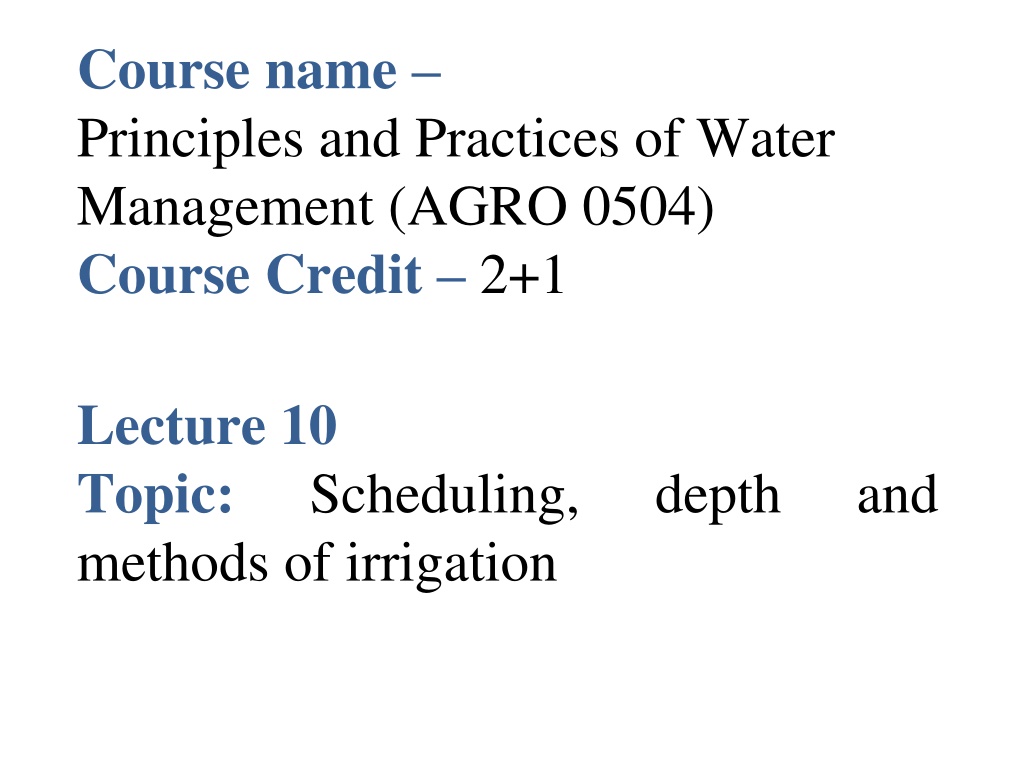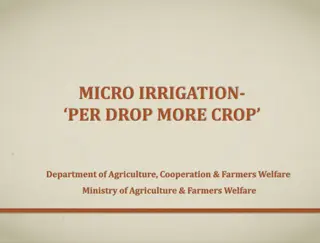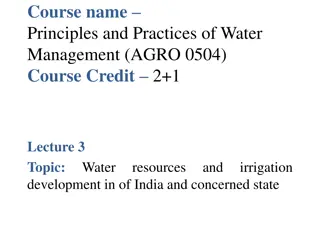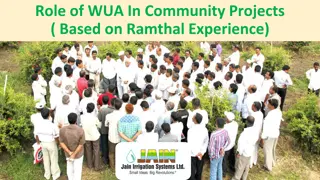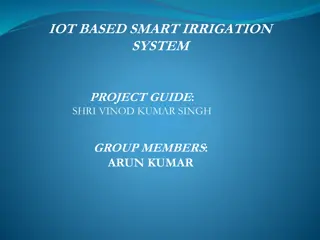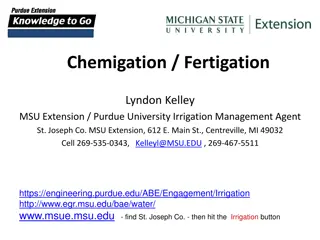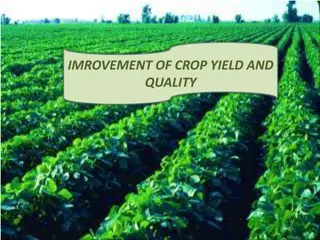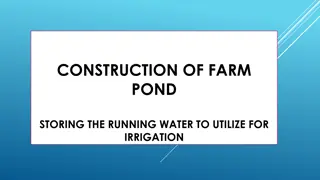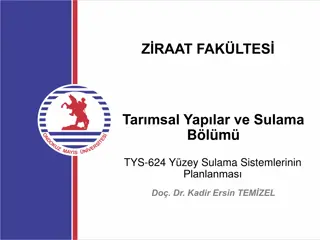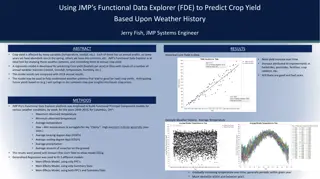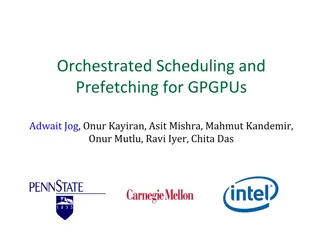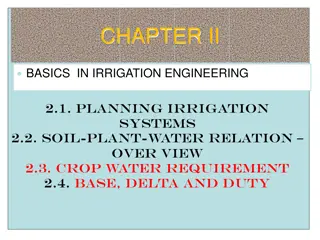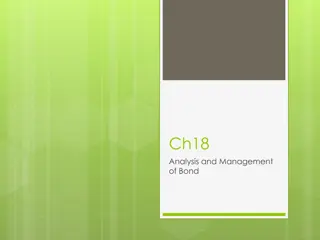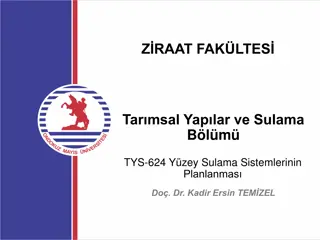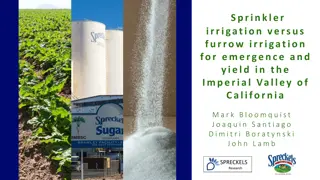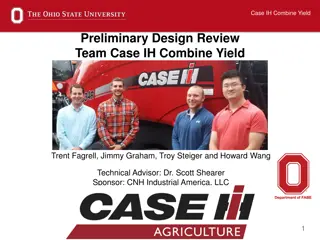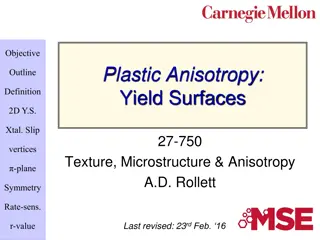Understanding Irrigation Scheduling for Optimal Crop Yield
Scientific irrigation scheduling plays a vital role in determining the correct timing and quantity of water application for crops to enhance yields efficiently while preserving soil quality. Various criteria are utilized in irrigation scheduling, such as potential evapotranspiration (PET) estimation and lysimeters for accurate measurement. By employing advanced techniques and data on meteorology, crops, and soil, farmers can optimize water usage effectively.
Download Presentation

Please find below an Image/Link to download the presentation.
The content on the website is provided AS IS for your information and personal use only. It may not be sold, licensed, or shared on other websites without obtaining consent from the author. Download presentation by click this link. If you encounter any issues during the download, it is possible that the publisher has removed the file from their server.
E N D
Presentation Transcript
Course name Principles and Practices of Water Management (AGRO 0504) Course Credit 2+1 Lecture 10 Topic: methods of irrigation Scheduling, depth and
Scheduling of irrigation Scientific irrigation scheduling is a technique providing knowledge on correct time and optimum quantity of water application at each irrigation to optimize crop yields with maximum water use efficiency and at the same time ensuring minimum damage to the soil properties. Meteorological data (temperature, Wind speed, sunshine, relative humidity and rain fall), crop data (growth dates, crop coefficient and root zone) and soil data (soil texture, available soil moisture and initial soil moisture) is used to calculate irrigation water requirements for crops (Allen et al., 1996). In this work, water use for sectors other than agriculture has not been considered in the water balance, because it is mostly a non- consumptive use and generally negligible when compared to agriculture water use.
Criteria for scheduling irrigation With the advancement of knowledge in the field of soil-plant-atmospheric system several criteria for scheduling irrigations are now available and are being used by investigators and farmers. All the available criteria can be broadly classified into the following three categories:
Potential evapotranspiration (PET) Penmen (1948) introduced the concept of PET and he defined it as the amount of water transpired in a unit time by short green crop of uniform height, completely covering the ground and never short of water . He further stated that PET cannot exceed panevaporation under the same weather conditions and is some fraction of pan evaporation. PET can be estimated by several techniques viz., lysimetric methods, energy balance, aerodynamic approach, combination of energy balance and empirical formulae etc., and irrigation s can be scheduled conveniently
Lysimeter By isolating the crop root zone from its environment and controlling the processes that are difficult to measure, the different terms in the soil water balance equation can ben determined with greater accuracy. This is done in lysimeters where the crop grows in isolated tanks filled with either disturbed or undisturbed soil
Different types of lysimeters vary widely in the accuracy with which changes in soil water are detected. In precision weighing lysimeters, where the water loss is directly measured by the change of mass, evapotranspiration can be obtained with an accuracy of a few hundredths of a millimetre, and small time periods such as an hour can be considered. In non-weighing evapotranspiration for a given time period is determined by deducting the drainage water, collected at the bottom of the lysimeters, from the total water input. lysimeters the
Cumulative pan evaporation Earlier transpiration of a crop is closely related to free water evaporation from evaporimeter .Thus, the open pan evaporimeter being simple and as they incorporate the effects of all climatic parameters into a single entity i.e., pan evaporation could be used as a guide for scheduling irrigation s to crops. For example, Wheat required 75 to 100 mm CPE at Ludhiana Sugarcane required 75 mm CPE in Maharashtra Greengram required 180 mm CPE at Ludhiana Sunflower required 60 mm CPE at Bangalore investigations have shown that an open pan
IW : CPE ratio Prihar et al. (1974) advocated irrigation scheduling on the basis of ratio between the depth of irrigation water (IW) and cumulative evaporation from U.S.W.B. class A pan evaporimeter minus the precipitation since the previous irrigation (CPE). An IW/CPE ratio of 1.0 indicates irrigating the crop with water equal to that lost in evaporation from the evaporimeter. Few examples of optimal IW/CPE ratios for important crops are given in Table.
Optimum IW/CPE ratios for scheduling irrigation in important crops
However, the criterion does not take into consideration the critical growth stages for irrigation. It may also not hold well under the following situations. 1. For crops requiring 1-2 irrigations only 2. Determining timing of first and last irrigation 3. Under low temperature/ frost/ salt stresses Further, the optimum value of CPE for fixed/ variable depth of irrigation has to be worked out for different crops and locations.
METHODS OF IRRIGATION Surface irrigation method refers to the manner or plan of water application by gravity flow to the cultivated land wetting either the entire field (uncontrolled flooding) or part of the field (furrows, basins, border strips).
Surface Irrigation Surface irrigation refers to irrigating lands by allowing water to flow over the soil surface from a supply channel at upper reach of the field. Most irrigation method followed in India. Principles involved are: i)Field is divided into plots or strips to uniformly irrigate the soil to a desired depth. ii)Water is discharged at the highest level of the field allowing water to flow down the gentle slope by gravity. iii)Water loss by run-off or deep percolation is avoided. iv) Efficiency of irrigation is kept at a high. v)Size of stream should be such as to have an adequate control of water.
Surface Irrigation Advantages Disadvantages 1)Variable size of streams can be 1)Considerable land is wasted in used. construction of channels and 2)Large flow of water can be bunds easily controlled. 3)Skilled persons are not 2)Initial construction cost is high. required. 3)Causes soil erosion 4)Cost of water application is low.
Methods involving complete flooding
Wild flooding Wild flooding refers to irrigating fields that are relatively flat and level by allowing water from supply channels to flow over the land surface along the natural slope without much guidance by channels and bunds. This method is exclusive for low land rice cultivation. Water is allowed from the channel to the entire field.
Wild flooding Advantages Disadvantages 1)Land does not require precise 1)Flooding is uncontrolled. 2)Uniform wetting of land cannot land leveling and grading. be achieved. 2)Water application is quite cheap 3)Excessive water loss may occur. and easy. 4)Water application efficiency is low. 3)Skilled labour is not required.
Border strip irrigation In this method, field is laid out into long, narrow strips, boundering with small bunds. Length of the strips ranges from 30 to 300 m and width from 3 to 15 m. Water from the channel is allowed into each strip at a time. Method is suitable for close growing crops and medium to heavy textured soils, but not suitable for sandy soil.
Border strip irrigation Types of border Straight border Contour border Borders are laid along the general slope of the field. Grading of the field is done by scraping away the surface soil from one part to other without affecting the soil productivity. Borders are laid across the slope of the field. It is normally done when slope of the land is very steep with a shallow soil depth and levelling is not feasible.
Border strip irrigation Advantages Disadvantages 1)No land is wasted for making channels excepting the supply 1)Initial construction cost is high. channel. 2)Precise levelling is essential. 2)Borders can be used for growing crops. 3)Enough skill is required in 3)Water application efficiency is applying water. high. 4)Labour requirement is low.
Check basin irrigation In this method, field is divided into small plots surrounded by bunds on all the four sides. Water from main channel is supplied to the field channels one after the other. Each field channel supplies water to two rows of check basins and water is applied to one basin after another. Size of check basins ranges from 4 m 3 m to 6 m 5 m depending on the stream size and soil texture. This method is the most common method among surface method of irrigation
Check basin irrigation Advantages Disadvantages 1)Precise land 1)Variable size of streams can be levelling is effectively used. essential. 2)It can be adopted for a wide 2)Considerable land is wasted by range of soil. bunds and channels. 3)Water application efficiency is 3)Movement of implements and high. machinery are often restricted by 4)Water logging condition can be bunds. easily created for rice crop. 4)Labour requirement is high.
Contour ditch irrigation In topography with sloping and rolling where land leveling is not economical, the contour ditch or contour channel irrigation is adopted. Supply ditches are constructed along with the contours at certain intervals depending on the slope of land. Water is flooded down the slope from the upper ditch to irrigate the lower land between two adjacent ditches.
Contour ditch irrigation Advantages Disadvantages 1)It does not require precise land 1)Labour cost is high. levelling. 2)Application efficiency is not 2)Cost of land preparation is low. high. 3)Chances of soil erosion are low.
Methods involving partial flooding
Furrow irrigation A method of surface irrigation in which water is delivered to the field through shallow ditches between ridges on which plants are grown. The size and slope of the furrow depends upon the crop grown, equipment s used and spacing between two crops. Crops like maize, sorghum, potato, tobacco and sugarcane etc. are suitable for this method of irrigation.
Types of Furrow irrigation Alternate furrow Broad bed and furrow Skip furrow Straight graded furrow Straight level furrow Contour furrow irrigation
Furrow irrigation Advantages Disadvantages 1)Uniform water application 2)High water efficiency 3)Wide range of soil can be irrigated 4)Variable sizes of stream can be used 5)More saving compared to flood method of irrigation 6)No erosion hazard application 1)Land requires precise grading to a uniform slope. 2)Labour requirement is high for grading land and making furrow. of water as 3)Un suitable for light soil.
Corrugation Corrugation means miniature furrows that are adopted for irrigating close growing crops. This method is suitable for fine to moderately coarse soil. Corrugation is V shaped or U shaped channels of about 10 cm depth, 40-75 cm apart. The slope should be just enough not to permit soil erosion. Corrugation is usually made after the crops shown but before germination of seed with simple implement called corrugator.
Corrugation Advantages Disadvantages 1)To save good amount of water 2)Small sized streams can be used 1)Not suitable for high rainfall effectively to prevent crusting of areas soil. 2)Not suitable where the land is 3)High water application leveled or slope is less than 1% efficiency 3)Not suitable for sandy soil. 4)No need of previous land leveling
Basin irrigation A basin is usually made for the tree sapling but it may include more than one sapling when they are not spaced very wide. Basin may be square, circular or rectangular. Water is supplied through laterals and each basin is connected to a lateral with a short and narrow furrow.
Ring irrigation In this method, a ring is laid at the periphery of the tree canopy. The dimension of ring trenches is 30-50 cm wide and 30 cm deep. This method is adopted in orchards.
Ring and Basin irrigation Advantages Disadvantages 1)Save considerable amount of irrigation water. 1)Adaptable only in orchard and 2)Reduce water losses through deep percolation and plantation crop. evaporation. 2)Restrict the movements of 3)Water application efficiency is animals and farm machinery. very high. 4)Control variable size of stream.
Sub-surface irrigation Sub surface irrigation or sub irrigation involves irrigation to crops by applying the water from beneath the soil surface either by constructing trenches or installing underground perforated pipe lines or tile lines. The principal crops that can be irrigated through this method are potato, sugar beet, vegetable, alfalfa coconut etc. In India, this method is commonly used in Kashmir for vegetable crops and in Kerala for coconut crop.
Sub-surface irrigation Conditions to be satisfied for application of Subsurface irrigation: High water table or a hard impermeable pan should be located bellow the root zone. High permeable surface soil such as loam or sandy loam is required. Uniform topographic condition and moderate land slope is required. Water used for irrigation should not be saline.
Sub-surface irrigation Advantages Disadvantages 1)Water is not lost through deep 1)Good quality irrigation water is percolation. required. 2)Minimum evaporation losses 2)Chance of soil salinity and from the soil surface. alkalinity due to upward 3)Operation of farm machinery is movement of salts with the water. possible at any time.
